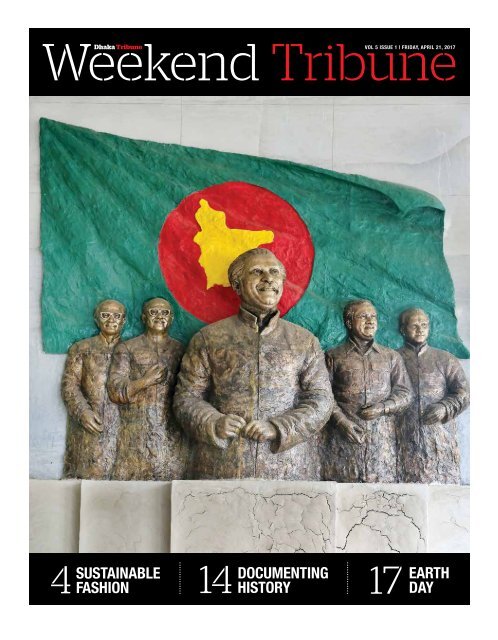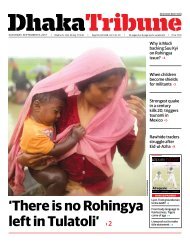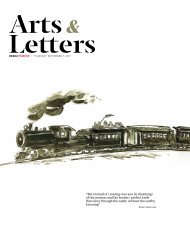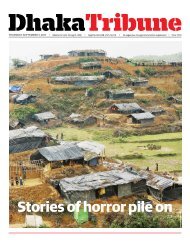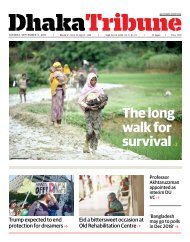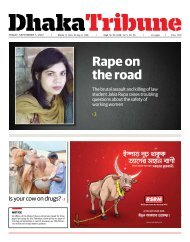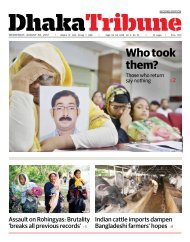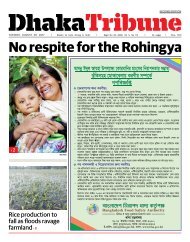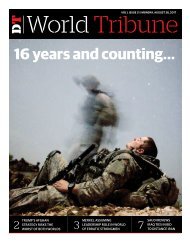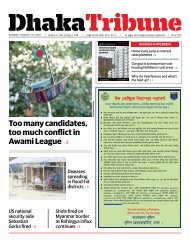Weekend-5-1
Create successful ePaper yourself
Turn your PDF publications into a flip-book with our unique Google optimized e-Paper software.
Dhaka Tribune<br />
vol 5 Issue 1 | FRIDAY, April 21, 2017<br />
4<br />
Sustainable<br />
fashion<br />
14 Documenting<br />
history<br />
17 Earth<br />
day
CONTENTS 1<br />
Volume 5 | Issue 1 | April 21, 2017<br />
Editor<br />
Zafar Sobhan<br />
Features Editor<br />
Sabrina Fatma Ahmad<br />
Magazine Editor<br />
Farina Noireet<br />
Deputy Magazine Editors<br />
Khan N Moushumi<br />
Shuprova Tasneem<br />
<strong>Weekend</strong> Tribune Team<br />
Saudia Afrin<br />
Moumita Ahmed<br />
Tasfia Huda<br />
Baizid Haque Joarder<br />
Saqib Sarker<br />
Mahmood Sadi<br />
Sabiha Akond Rupa<br />
Contributors<br />
Nisha Ali<br />
Mahmood Hossain<br />
Anika Humaira<br />
Farzana Romine<br />
Cartoons<br />
Syed Rashad Imam Tanmoy<br />
Priyo<br />
Graphics<br />
Md Mahbub Alam<br />
Alamgir Hossain<br />
Shahadat Hossain<br />
Colour Specialist<br />
Shekhar Mondal<br />
Advertisement<br />
Shahin Ahsan<br />
Production<br />
Masum Billah<br />
Circulation<br />
Masud Kabir Pavel<br />
Website<br />
dhakatribune.com/weekend<br />
facebook.com/<strong>Weekend</strong>Trib<br />
Email your letters to:<br />
weekend@dhakatribune.com<br />
6<br />
10<br />
Cook your own way<br />
Kitchen chronicles<br />
Photo Story<br />
Monkey business<br />
Editor’s note<br />
Dear Readers,<br />
Now that the fun and festivities of<br />
the Noboborsho have passed, it is<br />
time we take a solemn step towards<br />
a year that will hopefully bring peace<br />
and prosperity to all.<br />
Dhaka Tribune turned four this<br />
April 19, and like always, we aim to<br />
provide our readers with stories that<br />
will not only be a source of relevant<br />
news, but also pique their interests<br />
on a range of subjects.<br />
April 22 is International Mother<br />
Earth Day, and this week we bring to<br />
you a collection of articles relating<br />
to environment and conservation.<br />
We start off with our regular fashion<br />
section, featuring designer Maheen<br />
Khan in a moment of introspection<br />
about our consumerist choices.<br />
We then move on to an Earth Day<br />
Special page on locally made ecofriendly<br />
products. Our photo story<br />
features some rare close-ups of<br />
some of the famous furry inhabitants<br />
of Lawachara National Park, who are<br />
precariously close to being termed<br />
endangered unless more is done for<br />
conservation.<br />
April 16 also saw the inauguration<br />
of the new premises of the Liberation<br />
War Museum. We have a section<br />
dedicated to this new space for<br />
documenting history that will serve as<br />
a crucial source of information on the<br />
birth of our country for generations<br />
to come.<br />
Here’s wishing our readers a<br />
happy weekend.<br />
Farina Noireet<br />
News<br />
2 News<br />
3 Meanwhile<br />
Features<br />
4 Trending<br />
Sustainable fashion<br />
8 Earth Day<br />
Eco-friendly buys<br />
12 Fiction<br />
13 Interview<br />
Shamsul Alam Bir Uttam<br />
14 Space<br />
Documenting history<br />
16 Groceries<br />
Food safety<br />
17 Earth Day<br />
Lifestyle<br />
19 Gastronomy<br />
For the love of dim sum<br />
20 Health<br />
Depression<br />
Regulars<br />
9 Tailored<br />
18 Stay in<br />
On the cover<br />
Metal sculpture of Bangabandhu<br />
Sheikh Mujibur Rahman and four<br />
national leaders at the new premises<br />
of the Liberation War Museum<br />
Photo: Syed Zakir Hossain<br />
WEEKEND TRIBUNE | FRIDAY, APRIL 21, 2017
2 News | This week<br />
Local<br />
Two razakars to<br />
die for war crimes<br />
in Kishoreganj<br />
The world at a glance<br />
Two Russian jets ‘intercepted’<br />
by US fighter planes near Alaska<br />
Syria evacuations resume<br />
after deadly bombing<br />
A special tribunal has sentenced<br />
two collaborators to death for<br />
their involvement in the murder<br />
of over 60 people, arson and<br />
looting in Kishoreganj during the<br />
1971 Liberation War.<br />
The three-member<br />
International Crimes Tribunal<br />
headed by Justice Anwarul<br />
Haque pronounced the<br />
judgement in presence of one<br />
of the convicts, Muhammad<br />
Moslem Pradhan, 66 on last<br />
Tuesday.<br />
The other convict, Syed<br />
Mohammad Hussain alias<br />
Hossain, 54, is absconding. They<br />
were indicted on six charges of<br />
crimes against humanity on May<br />
6 last year.<br />
Charges brought against the<br />
duo include killing of 62 people,<br />
abduction and detention of 11<br />
people, and burning down some<br />
250 houses in Nikli upazila in<br />
collaboration with the Pakistani<br />
occupation forces.<br />
In this case, the prosecution<br />
prayed to the court to declare<br />
rape and forced religious<br />
conversions equal to genocide.<br />
The duo, both hailing from<br />
Kishoreganj sadar upazila, were<br />
given death sentence on charge<br />
No 3.<br />
News: Dhaka Tribune<br />
Egyptian police last Tuesday arrested a man<br />
wanted for alleged involvement in twin church<br />
bombings this month claimed by the Islamic<br />
State group, an official said.<br />
Acting on a tip-off, police arrested Ali<br />
Mahmoud Mohamed Hassan, one of 19 suspects<br />
whose names police made public after the Palm<br />
Sunday explosions, the official said.<br />
Two suicide bombers attacked two churches<br />
in the cities of Tanta and Alexandria on April<br />
9, killing 45 people in the deadliest attack on<br />
Coptic Christians in recent memory.<br />
Hassan was arrested in the southern province<br />
of Qena, from where the two suicide bombers<br />
also came.<br />
The interior ministry had raised a reward for<br />
US fighter planes have intercepted and escorted two<br />
Russian bombers in international airspace off the coast of<br />
Alaska.<br />
The TU-95 Bear bombers flew within 100 miles (160 km)<br />
of Alaska’s Kodiak Island before being intercepted by two<br />
American F-22 Raptors last Monday.<br />
The US pilots escorted the Russian planes for 12<br />
minutes before the TU-95s changed course and departed<br />
towards eastern Russia.<br />
CNN reported that the Russian planes were within<br />
international air space but inside the Alaskan Air Defence<br />
Identification Zone, meaning they should in theory have<br />
identified themselves and their destination. The planes<br />
were 280 miles south west of the Elmendorf Air Force Base<br />
when the Raptors were scrambled. The Russian planes<br />
also flew near the Aleutian Islands.<br />
Pentagon spokesman and Navy Commander Gary Ross<br />
said the intercept procedure was “safe and professional.”<br />
US officials also said the Russian behaved professionally,<br />
although there was no “cockpit-to-cockpit” radio contact.<br />
Monday’s incident was not the first incident. On July 4,<br />
2015 Russian bombers appeared off California and Alaska.<br />
Photo: Reuters<br />
Egypt arrests church bombings suspect<br />
information<br />
leading<br />
to the<br />
suspects’<br />
arrests to<br />
500,000<br />
pounds<br />
($27,518).<br />
The Palm Sunday bombings followed<br />
an earlier attack by a suicide bomber who<br />
detonated his explosives in a packed Cairo<br />
church in December, killing 29 people.<br />
The Islamic State group, which claimed all<br />
three bombings, has threatened more attacks on<br />
the minority, which makes up about 10 percent<br />
of Egypt’s 90 million people.<br />
Photo: AP<br />
Hundreds of Syrian civilians who have been under<br />
crippling siege left their homes last Wednesday as<br />
evacuations resumed after a weekend bombing<br />
killed dozens of others fleeing, nearly 70 of them<br />
children.<br />
A large convoy of buses from the governmentheld<br />
towns of Fuaa and Kafraya reached the edge<br />
of the rebel-held transit point of Rashidin outside<br />
second city Aleppo, the correspondent said.<br />
The Syrian Observatory for Human Rights<br />
confirmed the hard-won evacuation deal was back<br />
under way.<br />
“The process has resumed with 3,000 people<br />
leaving Fuaa and Kafraya at dawn and nearly 300<br />
leaving Zabadani and two other rebel-held areas,”<br />
the head of the Britain-based monitoring group,<br />
Rami Abdel Rahman, told AFP.<br />
Rashidin was the scene of Saturday’s deadly<br />
car bombing. At least 109 of the 126 dead were<br />
evacuees, among them 68 children. The rest were<br />
aid workers and rebels guarding the convoy.<br />
Dozens of wounded were taken to hospitals<br />
in nearby rebel-held territory, while others<br />
were taken to Aleppo, which government forces<br />
regained full control of late last year.<br />
Security was tightened up for Wednesday’s<br />
departures. Several dozen armed rebel fighters<br />
stood guard over the marshalling area where the<br />
buses were parked.<br />
The AFP correspondent said all other vehicles<br />
were carefully searched.<br />
The evacuations were taking place under a deal<br />
between the government and the rebels that is<br />
also seeing residents and rebels transported out of<br />
Madaya and Zabadani, towns near Damascus that<br />
are surrounded by pro-government forces.<br />
It was brokered late last month by Qatar, a<br />
longtime supporter of the rebels, and Iran, a key<br />
regime ally, but its implementation had been<br />
repeatedly delayed.<br />
When Wednesday’s evacuations are complete,<br />
a total of 8,000 people should have left Fuaa and<br />
Kafraya, including pro-government fighters as well<br />
as civilians.<br />
In exchange, 2,500 civilians and rebel fighters<br />
should have left rebel areas including Zabadani<br />
and Madaya.<br />
Photo: AFP<br />
WEEKEND TRIBUNE | FRIDAY, APRIL 21, 2017
. . . Meanwhile 3<br />
Photo of the week<br />
Jubilant crowds defy<br />
all threats and come<br />
together to celebrate<br />
the Bengali New Year<br />
during the annual<br />
Mongol Shobhajatra,<br />
now listed as a part of<br />
our intangible cultural<br />
heritage by UNESCO.<br />
Photo: Mahmud<br />
Hossain Opu<br />
Woman gets her hand stuck in her toilet<br />
and has to be freed by firefighters<br />
say what?<br />
Firefighters had to free a<br />
woman after she got her<br />
hand stuck in a toilet.<br />
Gracie Henderson had just<br />
moved into her new house and<br />
needed to unblock her toilet. But<br />
because she didn’t have a plunger,<br />
Gracie made the decision to carry<br />
out the task using her hands.<br />
However, she ran into problems<br />
immediately when her watch got<br />
stuck in the toilet basin, leaving her<br />
stuck fast.<br />
Poor Gracie had no choice but to<br />
call firefighters to her home in New<br />
Caney, near Houston in the USA to<br />
help free her.<br />
Crews had no choice but to<br />
remove the toilet, carry it into<br />
Gracie’s back garden – with her<br />
still attached to it by the arm. They<br />
eventually managed to free the<br />
embarrassed woman by smashing<br />
the porcelain bowl.<br />
Although<br />
poor Gracie’s<br />
neighbours were<br />
treated to quite<br />
a show as fire<br />
crews worked to<br />
free her.<br />
Thankfully,<br />
Gracie has been<br />
uninjured by her ordeal and was<br />
such a good sport she shared the<br />
video online, where it has been<br />
viewed thousands of times.<br />
News and photo: Mirror Online<br />
horoscopes<br />
Aries (Mar21-Apr19): This week is<br />
a good time to avoid overreacting.<br />
Also steer clear of petty arguments.<br />
However, it can be perfect for<br />
romance and a special evening out.<br />
Taurus (Apr20-May20): Although<br />
you may be busy, you could have<br />
a powerful desire to kick back and<br />
relax at the start of the week. You<br />
may also find that unexpected<br />
tasks or deadlines show up.<br />
Gemini (May21-June20): The lively<br />
sparkle around leisure activities<br />
and your social life continues, with<br />
a powerful influence enhancing<br />
feelings on Saturday. If you want<br />
to ask someone out on a date, this<br />
could be the day to make your<br />
move.<br />
Cancer (June21-Jul22): When<br />
it comes to your career and<br />
key ambitions, an unexpected<br />
opportunity could open the door to<br />
a startling new vista, which could<br />
prove beneficial if you accept it.<br />
Leo (Jul23-Aug22): Be careful what<br />
you say, especially on Sunday, as<br />
it could be all too easy to become<br />
irritated by a minor matter. Try<br />
a massage, spa treatment, or<br />
anything that will help you relax.<br />
Virgo (Aug23-Sep22): The desire to<br />
splurge could be very strong early<br />
in the week, and you could hit<br />
the mall or shop online. Go easy,<br />
though.<br />
Libra (Sep23-Oct22): Avoid making<br />
spontaneous decisions until you<br />
feel calmer and more settled.<br />
Relationships seem to be an<br />
ongoing theme. Someone close<br />
could spring a surprise on you.<br />
Scorpio (Oct23-Nov21): Be<br />
prepared for fresh opportunities<br />
regarding work or everyday<br />
routines. Information could come<br />
out of the blue that moves you in<br />
a new direction. A new romantic<br />
attraction seems to hold promise<br />
this weekend.<br />
Sagittarius (Nov22-Dec21): This<br />
week, avoid hanging out with<br />
people who do nothing but<br />
complain. Stick with those who are<br />
upbeat and you’ll get the week off<br />
to a great start.<br />
Capricorn (Dec22-Jan19): Be<br />
prepared for some disruption to a<br />
family plan, this weekend. It may<br />
be minor, but try to give yourself<br />
more leeway around Thursday so<br />
you can handle any unexpected<br />
snafus.<br />
Aquarius (Jan20-Feb18): The week<br />
could bring unusual news that<br />
coincides with an opportunity or<br />
perhaps an encounter you might<br />
relish. Something or someone<br />
intriguing and refreshingly<br />
different may be about to enter<br />
your life.<br />
Pisces (Feb19-Mar20): The<br />
temptation to spend could be strong,<br />
but at the same time you’ll have a lot<br />
of fun. Just make sure you can afford<br />
it so there are no regrets.<br />
WEEKEND TRIBUNE | FRIDAY, APRIL 21, 2017
4 Trending | Sustainable fashion<br />
‘Earth Day is a good<br />
time to spiritually<br />
connect with all the<br />
decisions that make us<br />
humane’<br />
FDCB President Maheen Khan gets candid about the environment<br />
Sabrina Fatma Ahmad<br />
April already sizzles with<br />
the portent of a scorching<br />
summer ahead of us, and<br />
as Earth Day rolls around,<br />
it bears thinking seriously about this<br />
little planet we call home. Putting<br />
aside larger climate change issues<br />
such as oil wells and coal mines and<br />
carbon emissions, one industry that<br />
has recently been seeing a lot of flak<br />
is the fashion industry, particularly<br />
the rising threat of “fast fashion.”<br />
Eileen Fisher, award-winning<br />
clothing industry magnate has even<br />
gone so far as to say “The clothing<br />
industry is the second largest<br />
polluter in the world ... second only<br />
to oil.”<br />
From filling landfills with<br />
discarded clothings, to chemical dyes<br />
polluting the water, to microfibres<br />
choking marine wildlife, and<br />
certainly not least of all, the human<br />
rights abuses in fashion sweatshops,<br />
the evils of fast fashion are many.<br />
While Bangladesh, with its<br />
sizeable garments sector, is certainly<br />
no stranger to these problems<br />
(one has merely to glance at the<br />
Buriganga for visual confirmation),<br />
the couture scene is actually working<br />
extremely hard to make fashion<br />
more sustainable in as many ways as<br />
possible. From promoting fair trade<br />
to the use of organic vegetable dyes,<br />
local designers have been tireless in<br />
their attempt to be more responsible<br />
in their practices.<br />
You can’t begin to talk about<br />
sustainable fashion without<br />
mentioning khadi. The ancient<br />
handwoven and handloom textile<br />
is labour intensive, and has a much<br />
lower carbon footprint than other<br />
textiles, and can be a bridge between<br />
our rich cultural heritage and fashion<br />
of the future.<br />
Over the past two years, the<br />
Fashion Design Council, Bangladesh,<br />
has been relentlessly promoting<br />
these textiles, and with two<br />
consecutive years of successful<br />
festivals, have definitely made<br />
ripples of awareness about our<br />
handloom traditions.<br />
On Earth Day, however, Maheen<br />
Khan, founder of the fashion house<br />
Mayasir, and President of the FDCB,<br />
appears to be in a brooding frame of<br />
mind. “We’ve been trying to show,<br />
through our shows, how khadi is the<br />
ideal fabric for the Bangladeshi heat<br />
and humidity. Not only is it a more<br />
eco-friendly fabric, but requires very<br />
little capital investment to set up and<br />
can help generate income in rural<br />
households, particularly for women,<br />
for whom economic independence<br />
is important,” she says. “However,<br />
unless we are able to remunerate<br />
the labour of the khadi artisans at<br />
market value, they are forced to look<br />
for other means of employment.<br />
Our studies have shown large<br />
numbers of weavers migrating to<br />
other professions to sustain their<br />
families. Naturally, the handloom<br />
and handwoven industry takes a hit.<br />
The scenario is quite bleak.”<br />
A lot of this forced migration<br />
can be blamed on the demand<br />
for mass-produced readymade<br />
garments, and the popularity of<br />
Indian and Pakistani clothes as<br />
opposed to local textiles and local<br />
styles. Other environmental factors<br />
that contribute to this is the lack of<br />
locally produced cotton, owing to<br />
water shortages, climate change, and<br />
the dwindling of arable land.<br />
The iconic fashion designer<br />
refuses to get pessimistic, however.<br />
“People are slowly starting to care<br />
about these things. They’re getting<br />
more interested in things like where<br />
their food comes from, expressing<br />
concern about things like formalin or<br />
other forms of food adulteration. I’d<br />
like to think this growing awareness<br />
will bleed into other areas of life,<br />
such as clothing choices. We at the<br />
FDCB are of course, continuing our<br />
efforts to promote green fabrics.”<br />
As Maheen Khan and her<br />
compatriots gear up for the annual<br />
khadi festival in December, her<br />
message to readers and fashion<br />
enthusiasts is to try and instill good<br />
environmental values in the next<br />
generation, and to practice green<br />
fashion by respecting tradition,<br />
buying organic clothing, and<br />
adopting practices such as recycling<br />
and upcycling. “Don’t try to just go<br />
for a readymade Bollywood outfit.<br />
Take your own piece, be it a kurti<br />
or even a cotton sari, and try to use<br />
your imagination to accessorise, and<br />
mix and match, and make it your<br />
own.” •<br />
WEEKEND TRIBUNE | FRIDAY, APRIL 21, 2017
5<br />
Fast fashion facts<br />
• 2 billion pairs of jeans are produced globally every year. It take 7000<br />
litres of water to make just one pair (Source: Forbes magazine)<br />
• It takes 2700 litres of water to make just one machine-made cotton<br />
t-shirt (Source: bettercotton.org)<br />
• An estimated 400 billion square meters of textiles are produced<br />
annually, of which 60 billion square meters are left on the cutting<br />
room floor (Source: greenpeace.org)<br />
• Only a quarter of discarded garments gets recycled. The rest go to<br />
landfills, or are incinerated (Source: greenpeace.org)<br />
1.7 million tonnes of various chemicals are used<br />
annually around the world to dye/waterproof<br />
clothes. A lot of these chemicals leach into our<br />
rivers, harming wildlife Photo: Syed Zakir Hossain<br />
“Buy less,<br />
choose<br />
well, make<br />
it last”<br />
- Vivianne Westwood<br />
• Instead of splurging on<br />
a new garment you’re<br />
going to tire of in a month,<br />
arrange for clothes swap<br />
programmes with your<br />
friends. The perfect<br />
excuse to make a party of<br />
it. Youtube has plenty of<br />
“haulternative” videos to<br />
help you organise these.<br />
• Upcycling! Put your craft<br />
skills to use (or get your<br />
tailor involved) to turn old<br />
garments to new. Thus<br />
an old sari can be made<br />
into a new kameez, an old<br />
kameez into a new kurti,<br />
and so on and so forth<br />
• Look for eco-friendly<br />
options, such as clothes<br />
that use vegetable dye<br />
The rising popularity of fast fashion is forcing<br />
handloom weavers out of jobs Photo: Rajib Dhar<br />
WEEKEND TRIBUNE | FRIDAY, APRIL 21, 2017
6 Cook your own way | Kitchen chronicles<br />
Organic edibles<br />
No animals were hurt in the making of these desserts<br />
Farzana Romine<br />
Good vegan desserts are a bit challenging to make. It’s difficult to make most desserts without dairy or eggs. But<br />
sometimes when I invite a lot of people, I try to make sure that, if there is anyone vegan, he/she can have some<br />
options for dessert. It’s not something that you will make often, but it’s good to have some easy recipes ready, just in<br />
case you need it.<br />
Today I am sharing two easy vegan dessert recipes, which you can make in a very short time and with some<br />
common ingredients. It tastes so good that anyone will enjoy them.<br />
Vegan<br />
Eton Mess<br />
(Serves 4 people)<br />
WEEKEND TRIBUNE | FRIDAY, APRIL 21, 2017
7<br />
Ingredients:<br />
• 1 can of good quality coconut<br />
milk<br />
• 1/3 cup toasted almond flakes<br />
• 1 cup berries (any berries you<br />
like; tropical fruits like mango,<br />
pineapple work well too)<br />
• 2 tsp powdered sugar<br />
• 1/4 cup crushed vegan<br />
meringue cookies<br />
Photos: Farzana Romine<br />
For the vegan meringue cookies:<br />
• Brine from 1 can of chickpeas<br />
• ½ tsp cream of tartar<br />
• 2 tbsp powdered sugar<br />
Directions:<br />
To make the vegan meringue,<br />
drain and keep the liquid from a<br />
tin of chickpeas. With an electric<br />
beater, whisk this liquid on high<br />
until frothy. Add the cream of<br />
tartar and sugar. Keep whisking<br />
until the mixture reaches glossy<br />
stiff peaks.<br />
Line a baking tray with baking<br />
paper and spoon or pipe dollops<br />
of this mixture. Bake in the oven<br />
on low for one hour or until set.<br />
Allow to cool completely before<br />
crushing.<br />
When you buy the coconut<br />
milk, look for the one that has<br />
the highest fat content. Keep<br />
it in the fridge for a few hours<br />
or overnight. Open the can and<br />
scoop out the thick cream from<br />
top. Now mix the sugar with the<br />
coconut cream until it is smooth<br />
and light. Don’t over beat.<br />
Now mix the berries and<br />
crushed cookies with this cream.<br />
Top it off with the toasted<br />
almonds and some extra berries<br />
and serve.•<br />
Vegan<br />
chocolate<br />
mousse<br />
The brine that we usually discard<br />
when we use canned chickpeas, is<br />
known as “Aquafaba”. It’s a unique<br />
mix of starches, proteins, and<br />
other soluble plant solids which<br />
have migrated from the seeds<br />
to the water during the cooking<br />
process that gives aquafaba a wide<br />
spectrum of emulsifying, foaming,<br />
binding, gelatinising and thickening<br />
properties. Aquafaba can be used to<br />
replace egg whites in many sweet<br />
and savoury recipes.<br />
Ingredients:<br />
• Brine from one can of chickpeas<br />
• 3 tbsp sugar<br />
• 90 to 100 gram of good quality<br />
bittersweet chocolate (You can<br />
add more if you want)<br />
• 1/4 cup coconut cream<br />
Directions:<br />
After draining the chickpeas, keep<br />
the liquid in the fridge for a few<br />
hours, until very cold.<br />
Melt the chocolate with the<br />
coconut cream and cool it down to<br />
room temperature.<br />
In a clean bowl pour the chickpea<br />
liquid and start beating with a whisk<br />
or beater. It takes a bit longer than<br />
egg whites. Once soft peaks are<br />
formed, start adding the sugar one<br />
tablespoon at a time and beat until<br />
stiff.<br />
Mix 1/3 of the fluffy mixture into<br />
the chocolate. This will loosen up the<br />
chocolate. Add the rest of the fluffy<br />
mixture and gently fold them in. Be<br />
careful not to knock all the air out.<br />
Once done, pour them in serving<br />
ramikens or dessert glasses and chill<br />
for a few hours before serving. •<br />
WEEKEND TRIBUNE | FRIDAY, APRIL 21, 2017
8 Earth Day | Eco-friendly buys<br />
Nature knows best<br />
Fantastic organic products and where to find them<br />
Moumita Ahmed and Tasfia Huda<br />
The world is currently observing<br />
a growing trend, where an ever<br />
increasing number of people are<br />
turning towards using natural and<br />
herbal products. They are becoming<br />
more educated about the unsafe<br />
reactions of synthetic items, and<br />
are thus moving towards herbal<br />
solutions. This Earth Day, we bring<br />
you some tips on the best natural<br />
beauty products and home-grown<br />
organic produce, and where to find<br />
them.<br />
JATRA<br />
In the beginning of 2015, Jatra<br />
started a venture called Matir Mela.<br />
The idea was to decrease the misuse<br />
of earth’s natural resources, and find<br />
eco-friendly options that guarantee a<br />
better world for future generations.<br />
With a view to reducing waste<br />
and embracing conscious living,<br />
Anusheh Anadil, activist and founder<br />
of fairtrade eco craft store, Jatra,<br />
collaborated with Saba Humaira<br />
Ahmad, environmental activist and<br />
blogger, and came up with the idea<br />
of making homemade daily products<br />
like toothpaste, shampoo, lotions<br />
and cosmetics. Jatra not just sells the<br />
raw materials needed to make these<br />
items, but also makes handmade lip<br />
balm, natural mosquito repellent<br />
candles and other sustainable<br />
household products, using unrefined<br />
organic coconut oil, beeswax, etc<br />
sourced from local villages around<br />
Bangladesh.<br />
A few of the star ingredients they<br />
use are:<br />
Gram flour<br />
Also known as chickpea flour, or<br />
beshon, this is a traditional cleanser<br />
for hands, face, body and hair. It’s<br />
effective for removing dirt without<br />
upsetting the body’s natural<br />
moisture balance.<br />
Soap nuts<br />
Usually called reetha in Bangla,<br />
Natural, cruelty-free<br />
products at Jatra<br />
• Shaving kits in wood boxes<br />
that come with mini soap<br />
for lathering, alum stone for<br />
disinfecting and a lotion bar<br />
for moisturising.<br />
• Candles made of pure beeswax<br />
(plain or with neem or clove)<br />
in recycled glass jars, that will<br />
burn for at least 16 hours.<br />
• Sachets of kalojeera (nigella<br />
seeds) that you can bash<br />
lightly, and then inhale to<br />
unblock a stuffed nose.<br />
• Recycled glass jars with fabric<br />
holders that can be used as a<br />
beverage mug.<br />
• Reusable baby diapers/<br />
nappies.<br />
• An alum stone (phitkiri) that<br />
can be used as an effective<br />
natural, stain-free deodorant.<br />
A tiny, lightweight,<br />
packaging-free cube will last<br />
more than a year.<br />
• A lotion bar, which is actually<br />
body lotion in a solid bar<br />
that you rub over your limbs.<br />
It’s perfect for dry skin and<br />
made with only two quality<br />
ingredients: pure beeswax<br />
and raw coconut oil.<br />
• A fabric sponge to remove<br />
makeup and clean your<br />
face. Using this will replace<br />
eye makeup remover, face<br />
cleanser, rosewater toner,<br />
and the disposable cotton<br />
pads and Q-tips required to<br />
apply these.<br />
soap nuts are actually dried fruit<br />
shells, used for thousands of years<br />
in Asia and by Native Americans as<br />
a natural soap. They are great for<br />
washing clothes, and work well as<br />
a fabric softener as well. They are<br />
mild and hypo-allergenic, making<br />
them perfect for those with sensitive<br />
skin. They can be reused up to three<br />
times before composting them back<br />
in nature.<br />
Coconut oil<br />
Real coconut oil has been replaced in<br />
recent years by refined, chemically<br />
processed and diluted commercial<br />
versions, that bear little resemblance<br />
to the original product. Jatra<br />
however, is the first place in Dhaka to<br />
sell the real deal.<br />
DHAKA DOUGH<br />
With the hope that Bangladesh would<br />
not lag behind in appreciating the<br />
many benefits of organic production,<br />
Dhaka Dough began their journey in<br />
November, 2015. They started small<br />
but in over a year their popularity<br />
grew among Dhakaites.<br />
In order to help promote the<br />
country’s economy and to focus<br />
on long term sustainability, their<br />
concept is to obtain only Deshi<br />
supplies and make sure that Dhaka<br />
Dough’s products are as fresh as<br />
possible.<br />
Dhaka Dough also has an<br />
environment friendly return policy<br />
for their food grade containers, and<br />
makes sure that they are consistently<br />
reusable. Most of their products are<br />
sold per gram/kilogram, starting<br />
from Tk55.<br />
Grain<br />
A variety of grains such as rice flour,<br />
kalojeera polaw rice, whole wheat<br />
flour, and millet is being offered by<br />
Dhaka Dough. The health conscious<br />
population has relearned the benefits<br />
of unrefined, manually processed,<br />
fibre-rich versions and Dhaka Dough<br />
Dhaka Dough also offers a<br />
variety of other products,<br />
which include:<br />
• Flaxseed<br />
• Bay leaf<br />
• Kashundi<br />
• Mango pickle<br />
• Garlic pickle<br />
• Date molasses<br />
• Almond milk<br />
• Murki<br />
• Lip balm<br />
is helping “back to school” process.<br />
Honey<br />
Dhaka Dough procures their honey<br />
directly from the Sundarbans. It<br />
is done during the honey hunting<br />
season, which is April to June,<br />
which is later filtered and poured<br />
into wooden containers without any<br />
tampering in-between.<br />
Oil and Butter<br />
From coconut oil, mustard oil,<br />
sesame oil, almond oil, to flaxseed<br />
oil, peanut oil and black cumin,<br />
Dhaka is offering a wide range of oil.<br />
They are even selling peanut butter<br />
on top of their regular butter.<br />
Spices<br />
As Dhaka Dough wants their<br />
products to be as natural as possible,<br />
they try to procure their spices<br />
from local sources. The chilli<br />
comes from Bogra and turmeric is<br />
acquired directly from the hill tracts<br />
in Bandarban. The other spices<br />
available on their website are mace<br />
(joyotri), clove, coriander powder,<br />
cardamom, isabgol (psyllium husk),<br />
cumin powder, ground cinnamon,<br />
and pistachio. •<br />
WEEKEND TRIBUNE | FRIDAY, APRIL 21, 2017
Fashion editorial | Tailored 9<br />
Spring fashion<br />
at 30,000 feet<br />
You know you’re in an advanced stage of style<br />
when you have to change up your airport outfit<br />
according to season<br />
Mahmood Hossain<br />
Spring/summer is in full<br />
swing and all of your<br />
favourite or popular<br />
clothing stores and brands<br />
are putting their new collections on<br />
display. This usually the best time<br />
to update your wardrobe, given that<br />
the relentless sun is on your back<br />
throughout the entire day. What you<br />
airplane will drop temperatures almost<br />
drastically. It’s best to have a denim<br />
jacket. Keep in mind, we’re hanging<br />
out around the casual department<br />
when it comes to airport wear. And if<br />
it’s going to be a lengthy flight, you’ll<br />
want to be as comfortable as possible.<br />
The denim jacket is sophisticated<br />
enough to heighten your look, and<br />
comfortable enough to slip in-andout<br />
of. Ultimately, even with your<br />
destination in mind, the only time<br />
you’ll be donning the jacket is when<br />
you’re safely in your assigned seat. No<br />
one is telling you to flaunt it around<br />
like you’re on the runway.<br />
may not know is that there is actually<br />
a proper outfit for the new season as<br />
you decide to book your ticket to fly<br />
abroad. We’ve discussed travelling<br />
wardrobes in the past, but here’s<br />
a sure hit for any man planning to<br />
make a couple of trips above 30,000<br />
feet.<br />
Climate change<br />
With plenty of ludicrous politicians<br />
who continue to deny the rising<br />
tensions in climate change, you<br />
do have to consider where you’re<br />
departing from and where you’ll be<br />
landing. Dhaka, as we already know,<br />
is disgustingly hot. For the time<br />
being, we don’t have to deal with the<br />
infamous humidity in our tropical<br />
climate. This is where the outer most<br />
layer of this spring/airport look; the<br />
most important thing to have hanging<br />
on your arm.<br />
Most cooler climates will require<br />
a fresh new coat; however, our city<br />
requires something much lighter. Even<br />
though it’s hot outside, the airport and<br />
Safe with basics<br />
A basic white or any other solid<br />
coloured t-shirt is the ideal top<br />
underneath that denim jacket. While<br />
you’re channelling your inner James<br />
Dean, remember you want to feel<br />
as light as possible when waiting in<br />
unforgiving lines all the way to the<br />
boarding pathways. As you make<br />
sure you’ve applied your deodorant<br />
correctly and in all<br />
the right places,<br />
the white, cottonjersey<br />
t-shirt (even<br />
better if it’s linen)<br />
will you make<br />
you feel and look<br />
at ease. Literally,<br />
you cannot look<br />
any lighter than<br />
wearing a basic<br />
white, but with<br />
plenty of quality,<br />
t-shirt. And a<br />
crispy new t-shirt will never take away<br />
your classy take on something so<br />
casual.<br />
Not a fan of white? No worries, just<br />
make sure the shades you are aiming<br />
for on the lighter end of the spectrum.<br />
Something like a light blue or even<br />
pastel red will do just fine.<br />
From the waist, down<br />
Light-wash, slim-fit jeans are<br />
the go-to airport bottoms for the<br />
season. Sure, it might sound more<br />
comfortable to wear those fancy<br />
sweats from one place to another,<br />
but we’re talking about what’s “in”<br />
now, and<br />
not what<br />
used to be<br />
passable.<br />
Also, let’s<br />
be practical<br />
here. Sweats<br />
in this<br />
weather? If<br />
you think<br />
that to be<br />
acceptable,<br />
you’ve been<br />
drinking too<br />
much of that right-wing Kool-Aid.<br />
The entire idea behind this outfit<br />
is to look as light and fresh as you<br />
can. Naturally, light-coloured denim,<br />
protecting the family jewels and<br />
everything else below the waist,<br />
does the trick. Doesn’t matter if they<br />
are selvedge denim, stretch-denim<br />
Illustrations: Priyo<br />
or traditional washed and distressed<br />
denim, just make sure they are<br />
lighter shades of blue.<br />
Cushion those puppies<br />
As mentioned countless times<br />
before, the sneakers culture is here<br />
to stay. You’ve guessed it, a fresh pair<br />
of quality sneakers rounds off this<br />
season’s airport look. Nothing too<br />
crazy or fancy, just the right pair that<br />
compliments an already simple look.<br />
The shoes themselves should keep<br />
the shades in the same colour family.<br />
Be it Nike, Adidas, Converse, Vans or<br />
even in the higher-end departments<br />
like Lanvin, the contrasting colours<br />
shouldn’t stick out like a sore thumb.<br />
Look for subtle contrasts that are<br />
likely to mesh in well with your<br />
outfit. You want to look good and<br />
slightly different from the rest, but<br />
you don’t want to attract too much<br />
attention to you either.<br />
Think of yourself as a celebrity who<br />
simply cannot be bothered by the<br />
paparazzi but not too uppity to<br />
accept a compliment by a fellow<br />
passenger about your fly gear. •<br />
WEEKEND TRIBUNE | FRIDAY, APRIL 21, 2017
10 Photo Story | Monkey business<br />
Primates at Lawachara<br />
Spanning over 12 square kilometres area,<br />
Lawachara National Park was created in 1925<br />
through forestation. The trees planted then<br />
gradually expanded to become one of the major<br />
forest in the country. Rich in biodiversity the park<br />
attracts bird watchers from across the country, as<br />
well as people from outside of the national border.<br />
Khasi and Tipra tribes of indegenous people live in<br />
and around the park.<br />
Lawachara National Park houses a number<br />
of monkey species. Syed Zakir Hossain<br />
captured pictures of hoolock gibbons, a critically<br />
endangered species in Bangladesh. The other<br />
pictures are of the Phayre’s leaf monkey, which<br />
is also an endangered species. Hoolock gibbons<br />
are locally known as ‘woollook’ and Phayre’s leaf<br />
monkeys are known as ‘choshma pora honuman’.<br />
Photos: Syed Zakir Hossain<br />
WEEKEND TRIBUNE | FRIDAY, APRIL 21, 2017
11<br />
WEEKEND TRIBUNE | FRIDAY, APRIL 21, 2017
12 Fiction<br />
Page<br />
21<br />
through Muhammadpur, in a plastic<br />
bag being carried around by a man<br />
who sells “jhalmuri”.<br />
Feeling a little suffocated in there,<br />
I was soon sold off to a man who<br />
paid 10 bucks for the jhalmuri I was<br />
safeguarding in my pouch. Oh those<br />
freshly sliced lemons, tomatoes and<br />
chilli smelled like pure bliss!<br />
We jumped on a bus and it was<br />
then when I ran into my long lost<br />
friend, Page 7, who was carefully<br />
protecting some peanuts on the seat<br />
next to mine.<br />
Life cycle of a newspaper<br />
Khan N Moushumi<br />
Hi there! My name is Page 21 and I<br />
was born on April 3, 2017.<br />
It was a bright Monday morning.<br />
I had DT Sports written on my<br />
forehead. I was told, not in so many<br />
words though, that I was one of the<br />
many clones to have come out from<br />
our shared mother--the press--that<br />
day.<br />
I was printed in black and white,<br />
and I had a lot of sports-related info<br />
written all over me. There was also a<br />
big picture of West Indies’ cricketer<br />
Evin Lewis playing a shot at the third<br />
T20I pasted on my face.<br />
I went around Dhaka and after a<br />
bumpy, two and a half hour ride in<br />
a rowdy, green three-wheeler, I was<br />
dropped off at a distribution centre<br />
in Dhanmondi, but was soon picked<br />
up again and we headed towards a<br />
news-stand near Shankar.<br />
A guy named Kollol then stacked<br />
a few bundles of us on the back of<br />
his cycle and pedalled us around<br />
Dhanmondi, dropping us off at the<br />
doorstep or the patio of different<br />
structures. One by one, we were all<br />
gone.<br />
I remember landing on a<br />
brown doormat, and soon after a<br />
30-something lady came and picked<br />
me up.<br />
I watched her flip through the<br />
pages, taking a quick glance at the<br />
pictures and the headlines of the<br />
newspaper. I watched her staring,<br />
fixated at my second cousin Page 23,<br />
he had a picture of Canadian Prime<br />
Minister Justin Trudeau printed on<br />
him. I don’t blame the lady though,<br />
I mean, have you seen that smile<br />
on Mr Trudeau? Who wouldn’t be<br />
polarised by those pearly whites?<br />
I was left on the tea table for<br />
about half an hour or so until a<br />
middle-aged man approached me,<br />
then a young kid in his early teens<br />
and finally, an elderly woman who<br />
examined me through a pair of thick<br />
spectacles. The young boy was most<br />
excited to see me, he read the entire<br />
story on Lewis and how he crushed<br />
Pakistan in the T20.<br />
The next morning, I was thrown<br />
under the table in a basket with a<br />
bunch of other old newspapers.<br />
I sat there for a while. A few days<br />
passed, and I had my successors<br />
piling up on top of me. It was getting<br />
dark, boring, and quiet. I don’t<br />
remember when I passed out.<br />
When I woke up under the<br />
scorching sun, it was to a man<br />
yelling “Purano boi, khata, kagoz.”<br />
I was sitting on top of his head in<br />
what looked like an old, wicker<br />
basket; he was buying old books<br />
and newspapers from households in<br />
exchange for a red cent. And soon, as<br />
the day concluded, we were dumped<br />
in a small room where women and<br />
children would rip us off, tear us in<br />
half or quarters and make “thongas”<br />
(small paper bags) using glue.<br />
I quite enjoyed my time there,<br />
although heart-broken to be ripped<br />
apart from my family and friends. I<br />
watched those kids giggle away and<br />
talk about school or games while<br />
they folded and glued us together.<br />
A week later, I was travelling<br />
Illustration: Priyo<br />
Trying to hold back my tears, we<br />
exchanged greetings and he told<br />
me all about how others wound<br />
up. Page 15 and 17 were used for<br />
making hand fans, Page 4 was cut<br />
out to make paper flowers and that<br />
Justin Trudeau photo made it to the<br />
scrapbook of a 6th grader. Honestly, I<br />
couldn’t be any prouder.<br />
Next thing I remember, I was<br />
flicked in a dustbin, drenched in<br />
salt and oil from the remnants of<br />
the jhalmuri. There was nothing<br />
left of me. I was of no use, or so I<br />
thought. Two days later, I remember<br />
a tokai picked me up. I knew where<br />
I was headed next—the papermill<br />
again. To be washed, cleansed and<br />
recycled for a brand new page of the<br />
newspaper. •<br />
WEEKEND TRIBUNE | FRIDAY, APRIL 21, 2017
Shamsul Alam Bir Uttam | Interview 13<br />
“We are leaving you a country<br />
where you can flourish”<br />
A decorated war veteran discusses Kilo Flight<br />
Saqib Sarker<br />
Group Captain (retd)<br />
Shamsul Alam Bir Uttam’s<br />
name is inseparably<br />
associated with the<br />
birth of Bangladesh Air Force and<br />
by extension the history of the<br />
country itself. Along with a small<br />
number of rebel Bengali officers<br />
of the erstwhile Pakistani military,<br />
Shamsul Alam formed the very first<br />
fighting formation of the nascent<br />
Bangladesh Air Force, which was<br />
dubbed ‘Kilo Flight’. For his historic<br />
role in the liberation war he was<br />
awarded ‘Bir Uttam’. This year the<br />
veteran war hero has been awarded<br />
the Independence Award.<br />
Now in his 70s, the retired Group<br />
Captain strikes as more of an amiable<br />
grandfather figure than a former<br />
armed force personnel when you<br />
meet him in person. Perhaps age<br />
has mellowed him a bit but his<br />
diction has remained extremely<br />
sharp and his perspectives robustly<br />
straightforward. Most noticeably,<br />
his genuine enthusiasm for<br />
discussing history and Bangladesh is<br />
contagious.<br />
“Look, you probably want to<br />
know all about Kilo Flight. But<br />
I talked about that and they put<br />
out a video. I’ll give you the CD,”<br />
said Shamsul Islam, referring to a<br />
TV documentary made about the<br />
trainings and operation of Kilo<br />
Flight. “We will just chat,” he said,<br />
looking mischievously gleeful at the<br />
prospect of “chit-chatting”.<br />
“Listen, you cannot possibly<br />
fathom how incredibly poor we<br />
were,” said Shamsul Alam Bir Uttam,<br />
referring to the historic Bangladeshi,<br />
as he sat on a sofa at his residence,<br />
wearing a cream coloured punjabi<br />
and white lungi. “After the ‘bongo<br />
bhongo’ we got the first ever glimpse<br />
or a taste of independence. Because<br />
the Muslim majority population in<br />
this region never actually had any<br />
kind of autonomy. It’s not really a<br />
‘Hindu-Muslim’ thing at the core of<br />
it. But that is how the natives of this<br />
region felt,” he said.<br />
Being born in 1947, Shamsul<br />
Alam had the interesting historical<br />
opportunity of observing how the<br />
state of Pakistan unfolded and<br />
manifested itself. At the same time,<br />
he was within close proximity of<br />
colonial times and had a real sense of<br />
what it was like being the subject of<br />
British rule.<br />
“Lord Curzon divided Bengal to<br />
weaken the Hindu base,” he said.<br />
“We were happy because we felt we<br />
would no longer be dominated by<br />
and lorded over from Kolkata. We<br />
had nothing, nothing! Not any proper<br />
school or college,” he went on.<br />
“The Hindus built all the<br />
institutions and Muslim students did<br />
not have access. That’s just natural,<br />
because the local Muslims did not<br />
have anything from which they could<br />
build. All the scholarships went<br />
to the Hindus. Only a few Muslim<br />
students managed to enter into<br />
good quality mainstream education<br />
institutions. We used to ‘nomoshkar’<br />
them, because they owned<br />
Photo: Courtesy<br />
everything; they were the founder,<br />
the principles, the governing body<br />
and everything else.”<br />
The point Shamsul Alam was<br />
making was that the Bengali<br />
people never really knew what it<br />
was like to have freedom, what<br />
in modern language we call ‘selfdetermination’.<br />
However, despite<br />
being poor, the Bengali people<br />
were more educated than the West<br />
Pakistani people.<br />
“Bengal as a region was far<br />
superior in education than, for<br />
instance, Baluchistan, Punjab,<br />
Sindh etc. Although we had rejected<br />
education at first thinking English<br />
was the language of the ‘kafir’.<br />
That was our mental destitution.<br />
People starting from Titumir, Haji<br />
Shariatullah and everyone else was<br />
anti-British. But the Hindus accepted<br />
the language, so they were able to get<br />
jobs with the English administration.<br />
We fell behind a few hundred years<br />
by not accepting that education.”<br />
But life was good for Shamsul<br />
Alam as an officer at the Pakistan air<br />
force. “As a pilot officer first rank my<br />
salary was 1175 rupees. I was only<br />
24 then and that was a lot of money.<br />
Let me tell you what that money<br />
was worth in 1967. A European<br />
refrigerator then cost 600 to 800<br />
rupees. I could buy a brand new<br />
Toyota car after a year’s saving from<br />
my salary. It cost me 11,000 rupees,”<br />
explained Shamsul Alam.<br />
But the monstrous brutality of<br />
the Pakistan military on March 25<br />
and afterwards made it absolutely<br />
clear to Shamsul Alam and his peers<br />
that a freedom struggle was the only<br />
way left for Bangladeshi people to<br />
live with dignity. That propelled<br />
him to travel to East Pakistan risking<br />
his life. The story of his capture at<br />
the Tejgaon airport and subsequent<br />
release is no less thrilling than spy<br />
novels. Shamsul Alam crossed the<br />
border to India to eventually join<br />
with his comrades and ultimately<br />
form the Kilo Flight. His story would<br />
remain as one of the most glowing<br />
examples of fighting for what is right.<br />
What does he think of Bangladesh<br />
in 2017, the country he helped<br />
liberate? “Look, journalists like to<br />
print negative news all the time. Yes,<br />
you have to report the bad things. Do<br />
that. But also let people know about<br />
the bright side,” said Shamsul Alam.<br />
“We can now provide free<br />
textbooks to millions of students.<br />
No one has done that in the subcontinent.<br />
We are the fourth largest<br />
rice producer in the world, even<br />
though land mass has shrunk<br />
because of population. The media<br />
must gather up the courage to<br />
publish these achievements,” he<br />
added. As the chit-chatting neared<br />
to an end for the day, Shamsul Alam<br />
said that Bangladesh can now truly<br />
look forward to a future. “Your<br />
generation can achieve things that<br />
we never could. We are leaving<br />
you a country where you can really<br />
flourish,” the Bir Uttam said, a look<br />
of tranquil satisfaction glinting in his<br />
eyes. •<br />
WEEKEND TRIBUNE | FRIDAY, APRIL 21, 2017
14 Space | documenting history<br />
Photo: Syed Zakir Hossain<br />
‘A people’s<br />
museum’<br />
Photo: Syed Zakir Hossain<br />
The Liberation War Museum begins a new chapter<br />
<strong>Weekend</strong> Tribune Desk<br />
From 1996 to 2017, the<br />
Liberation War Museum<br />
(LWM) in Bangladesh<br />
has gone from being<br />
a budding project of a team of<br />
dedicated trustees to what they want<br />
to call a “people’s museum”. The<br />
group started off with scrounging<br />
together enough cash to create a<br />
trust fund and travel the nation in<br />
search of the stories of pain and<br />
pride from 1971, and collecting<br />
artifacts and information related<br />
to the Bangladeshi struggle for<br />
independence.<br />
20 years in the making, the<br />
LWM has finally shifted to its new<br />
premises in the capital’s Agargaon<br />
area, with the Honourable PM Sheikh<br />
Hasina formally inaugurating the<br />
museum on April 16, 2016. Designed<br />
by budding architect Tanzim Hasan,<br />
the 20,000 sq meter museum now<br />
houses over 21,000 artifacts that<br />
have been collected over the years.<br />
Wandering through the now<br />
expansive spaces of the Liberation<br />
War Museum, you not only learn the<br />
greater story of the Liberation War<br />
in more detail than what most of us<br />
know from formal education – it is<br />
the simpler stories of resistance, and<br />
glimpses into the lives of ordinary<br />
people living through extraordinary<br />
times, that really touches you. You<br />
see the black-and-white faces of<br />
freedom fighters, young men clad in<br />
simple lungis, who will never return.<br />
You see the faces of Birangonas<br />
Photo: Syed Zakir Hossain<br />
WEEKEND TRIBUNE | FRIDAY, APRIL 21, 2017
15<br />
intellectuals in the final few days of<br />
the war.<br />
But you also take immense pride in<br />
the pockets of resistance that flowered<br />
across the country; starting from the<br />
young women in guerrilla training<br />
to the fiery words of poets dreaming<br />
of revolution, the LWM invokes<br />
Photo: Syed Zakir Hossain<br />
“When we started off, we<br />
(the trustees) all contributed<br />
to a trust fund to set up the<br />
museum, no matter how<br />
difficult it was for us. How could<br />
we ask people for money for our<br />
cause, if we were not willing<br />
to invest in it ourselves? There<br />
are a lot of things in Bangladesh<br />
that make us feel frustrated,<br />
but we have learnt that if the<br />
country needs something, and<br />
if there are a group of people<br />
dedicatedly working towards<br />
it whose intentions cannot be<br />
questioned – then ordinary<br />
people will come together to<br />
show their support.<br />
We started off with only Tk<br />
25,000 each, and we needed Tk<br />
140 crore for the new premises.<br />
Of this, Tk 40 crore came from<br />
the government, but the rest<br />
simply came from ordinary<br />
people in Bangladesh, starting<br />
from donations from bank<br />
officials to tiffin money from<br />
school children. No foreign<br />
funds were involved.”<br />
- Dr Sarwar Ali, LWM trustee<br />
hopelessly staring into the distance,<br />
of children fearlessly running head<br />
on into protests, and the sheer horror<br />
of the torture inflicted on martyred<br />
what is perhaps even more relevant<br />
in 2016 – the spirit of 1971, and the<br />
unconditional love for one’s nation<br />
that made even the simplest farmer<br />
turn into a fearless freedom fighter.<br />
Photo: Syed Zakir Hossain<br />
The LWM’s galleries are truly<br />
an emotive experience, and filled<br />
with little gems that most of us<br />
have no idea exist, whether is the<br />
rudimentary contraptions used on<br />
rail tracks to transport necessary<br />
resources in a war-ravaged<br />
nation, a makeshift press used to<br />
print revolutionary slogans, or<br />
a newspaper clipping of the first<br />
time a football team representing<br />
Bangladesh, and not East Pakistan<br />
played the game to raise awareness<br />
about the war-torn nation. The<br />
museum’s representation of history<br />
comes in many layers, with a focus<br />
not only on the history of the war<br />
at home, but of the greater political<br />
game being played by world powers<br />
at the height of the Cold War, as well<br />
as the international focus on the<br />
genocide that occurred during those<br />
nine months.<br />
Photo: Syed Zakir Hossain<br />
Last but not least, the LWM also<br />
plays a crucial role in preserving the<br />
history that many would have us<br />
forget, such as a newspaper article<br />
written by the notorious war criminal<br />
Ghulam Azam on how Hindus<br />
cannot be friends with Muslims,<br />
and decrying the secularism that<br />
was the fire lighting the flames<br />
of revolution in an independent<br />
Bangladesh. In fact, the LWM played<br />
an important role in contributing<br />
evidence to the recent war crimes<br />
trials, and continues to add to some<br />
much-needed research on 1971<br />
through its Centre for the Study<br />
of Genocide and Justice, as well<br />
as the Institute of Liberation War<br />
Studies. On top of that, it constantly<br />
engages in outreach programmes for<br />
the younger generation, including<br />
organising museum visits and<br />
creating a mini museum on wheels<br />
to reach school children from across<br />
the country, as well as inspiring them<br />
to collect eye-witness accounts. So<br />
“The hugeness of what this<br />
museum has turned out to be<br />
has stunned us the most. This<br />
was always a personal and<br />
emotional project for us, and<br />
we have all worked together<br />
in the background to make<br />
this happen because we really<br />
believed in this – there was<br />
never any public posturing<br />
or vying for leadership. This<br />
museum is our gift to the next<br />
generation and we hope you will<br />
all come together and become<br />
involved in preserving it.”<br />
- Tariq Ali, LWM trustee<br />
“Everyone has contributed<br />
to the museum – from a<br />
schoolchild to a rickshaw puller,<br />
and a petty shopkeeper to a<br />
large-scale corporation. For<br />
this reason I think it truly is a<br />
people’s museum, but now we<br />
need to ensure that it continues<br />
to grow and evolve, and not just<br />
turn into a collection of exhibits<br />
within four walls.<br />
Our most important task<br />
now is to bring in the younger<br />
generation to not only know<br />
of the history of the Liberation<br />
War, but to assimilate the spirit<br />
of the time. Without this, it<br />
will not be possible to infuse<br />
new blood into the museum<br />
and hand over its care to a new<br />
generation that truly believes<br />
in it. Another important focus<br />
is obviously on doing proper<br />
historical research, as well as<br />
recording our oral history before<br />
it is too late.”<br />
- Asaduzzaman Noor, LWM<br />
trustee<br />
Photo: Syed Zakir Hossain<br />
far, over 28,000 records have been<br />
collected through this programme.<br />
According to LWM trustee Dr<br />
Sarwar Ali, “There was a time we<br />
were worried that many aspects<br />
of our history would be lost to the<br />
next generation. But the immense<br />
support we get, as well as the<br />
renewed interest in justice after the<br />
Shahbagh movement, has made us<br />
very hopeful. The museum’s journey<br />
has been a very emotional one, and<br />
we have high hopes of the next<br />
generation taking over and taking it<br />
further.” •<br />
WEEKEND TRIBUNE | FRIDAY, APRIL 21, 2017
16 Groceries | Food safety<br />
You are what<br />
you eat<br />
Options for healthy food in the local market<br />
Saudia Afrin<br />
The growing problem of food<br />
adulteration continues to be a<br />
health concern. However, people are<br />
more aware now than before, and<br />
instead of waiting for others to take<br />
initiatives to fix the situation, they<br />
are taking matters into their own<br />
hands and doing whatever possible<br />
to minimise the consequences of<br />
food adulteration in society and on<br />
themselves.<br />
How would you react if you found<br />
out that about half of the vegetable<br />
items in the markets are intoxicated<br />
by pesticides? Unfortunately, that<br />
is exactly what the situation is like.<br />
According to a survey conducted by<br />
the National Food Safety Laboratory<br />
(NFSL), with support from the Food<br />
and Agriculture Organisation (FAO),<br />
most of the vegetable items sold<br />
in the market are adulterated with<br />
pesticides.<br />
Civilians are<br />
purchasing and<br />
consuming fatal<br />
chemicals such<br />
as formalin and<br />
lead chromium<br />
along with their<br />
groceries<br />
Over time, the list of adulterated<br />
food items grew longer as several<br />
other daily grocery items were<br />
found to be adulterated as well.<br />
Even fish, chicken, fruits and spices<br />
have not been exempted from this<br />
list. Civilians are purchasing and<br />
consuming fatal chemicals such as<br />
formalin and lead chromium along<br />
with their groceries.<br />
A lot of mobile courts have<br />
appeared over time but the entire<br />
process of getting things under<br />
control is still just a work in progress.<br />
It’s high time people were made<br />
aware of it and something was being<br />
done to prevent it. But the fact that a<br />
few people and organisations started<br />
to combat the problem of food<br />
contamination, is probably the only<br />
silver lining.<br />
Jahan Dairy is one such<br />
organisation. To provide nutritious<br />
food for families, they began farming<br />
their own products. The rising<br />
demand for healthy food initiated<br />
this endeavour. Jahid Alam, one<br />
of the initiators said, “There is an<br />
endless demand for unadulterated<br />
food with zero supply. We wanted<br />
to grow vegetables and other food<br />
items for personal consumption but<br />
it was too expensive. That’s when we<br />
decided to start farming these items<br />
not for just ourselves, but for others<br />
looking to buy unadulterated food<br />
items as well. We wanted to serve<br />
people and also create a sustainable<br />
process.”<br />
Alam also informed that<br />
everything which include milk and<br />
milk products such as ghee, curd,<br />
deshi chicken and eggs and fish<br />
are produced in their own farm in<br />
Mawla, Gazipur. Vegetables and<br />
fruits are sold depending on their<br />
seasonal availability. A few products<br />
such as ghee are being processed<br />
as per order. Enriched by the<br />
knowledge of feasibility and demand<br />
gathered from pilot projects, Jahan<br />
Dairy has dedicated gardens for each<br />
fruit. Initially they have started with<br />
papaya, guava and mango.<br />
In the 16 bigha farm everything is<br />
farmed through natural processes.<br />
“In our chicken farm, we strictly<br />
avoid processed food, and we feed<br />
local rice grains. The same process<br />
has been applied to every other<br />
section. And in future our plan is<br />
to focus more on vegetable,” Alam<br />
said. Most of its customers are from<br />
Gulshan, Banani, Morpur DOHS,<br />
Dhanmondi, Uttara and Niketon.<br />
For nearer places home delivery<br />
is Tk50 and for deliver to distance<br />
destinations Tk100 is charged.<br />
Currently, Jahan Dairy takes orders<br />
from across the city throughout the<br />
week and home delivering on Fridays<br />
and Saturdays via their hotline<br />
number (+8801710990999).<br />
Sabuj Udyog, which specialises<br />
in the same sector are providing<br />
unadulterated red/white flour,<br />
deshi sugar, a variety of rice,<br />
spices, shudh ghee, achaar, honey,<br />
puffed rice, seasonal fruits etc.<br />
Apart from having their own farm,<br />
they also source their products<br />
from local farmers but only after<br />
they’ve ensured the quality of the<br />
produce. Sabuj Udyog has a store<br />
in 766/E, Road-7, Baitul Aman<br />
Housing, Adabor, Mohammadpur.<br />
They also take orders through their<br />
hotline number (+8801791002007).<br />
“About four years of journey, we<br />
never compromise with quality.<br />
With a consistent growing number<br />
everyday, currently we are serving<br />
more than 500 customers,” Firoz<br />
Infograph: Bigstock<br />
Alam, a sales executive of the store<br />
happily informed.<br />
Another similar initiative by<br />
Madol has been providing organic<br />
food for last ten months. Their<br />
products include rice, lentil, different<br />
types of spices, puffed rice, which<br />
they collect from reliable local<br />
farmers directly. While collecting<br />
food, Madol go for collecting<br />
products from renowned districts<br />
for each agricultural product. Belal<br />
Hossain, Manager, said, “Milk is<br />
collected from Madol’s own farm<br />
located in Savar. After collecting<br />
the seeds and raw materials from<br />
local farmers mustered oil, powder<br />
of coriander, turmeric and cumin<br />
are produced under the careful<br />
supervision of our staffs.” Till now,<br />
most of the selling are operated<br />
by its shop at Pathapath near<br />
Square hospital and home delivery<br />
is available for walking distance<br />
customers. This shop has around<br />
15 regular customers who hail from<br />
Uttara and Gulshan mostly on<br />
weekly basis to get their products.<br />
Siqat Food Shop offers kalijira<br />
honey, collected directly from<br />
farmers and Sundarban honey<br />
collected from the local mawali.<br />
They can be reached at their<br />
designated hotline as well<br />
(+8801875221866). •<br />
WEEKEND TRIBUNE | FRIDAY, APRIL 21, 2017
6<br />
ways to celebrate<br />
Earth Day<br />
Green practices to your everyday routine<br />
Sabiha Akond Rupa<br />
Turn off the taps already<br />
2 4<br />
No, we’re not asking you to be dirty, but there really isn’t<br />
On April 22, the world is going to any reason for having a half-hour long shower everyday.<br />
celebrate Earth Day in honour of As stated by the Environmental Protection Agency (EPA), a<br />
the environmental movement daily nice shower of ten minutes or more can consume up<br />
that began in the 1970s. While to 50 to 70 gallons of water. But according to water.org, a<br />
issues like pollution and climate change<br />
typical family in an African country uses only 10% of that<br />
require intervention on a policy level, there for an entire day; this includes drinking water, cooking<br />
remains the need for greater environmental and everything else. So why not just go back to the basics<br />
awareness on a micro level in Bangladesh. and use a bucket to ration your shower water, or just draw<br />
There are dozens of ways you can promote yourself a small bath? We also have a terrible habit of<br />
a healthy ecosystem and spread awareness, keeping the tap running while doing the dishes, when really<br />
not just tomorrow but all year long. Here are we just need a fraction of that in a bucket/washbasin to<br />
a few suggestions.<br />
soak our dirty dishes in and rinse.<br />
rewarding experiences.<br />
Life style | Earth day 17<br />
Give back to Mother Earth<br />
One of the best and easiest ways to<br />
celebrate Earth Day is by planting a tree<br />
anywhere you like. You can also have<br />
plants inside a corner of your own house<br />
and if you’re really feeling adventurous,<br />
why not try to grow some of your own,<br />
fresh food and ensure you bypass the<br />
pesticides? You can grow low maintenance<br />
vegetables like tomatoes, ladies-fingers,<br />
eggplants, chilies, curry leaves, tulsi and<br />
aloe vera. Even if it is only a little flower,<br />
you’ll find that making something grow<br />
from a seed or sapling can be a surprisingly<br />
1<br />
good idea, but just think of how much of your<br />
Give up the comfy cars<br />
In this hot weather, this may not sound like a<br />
carbon footprint you can reduce by using<br />
alternatives. You don’t have to do it daily –<br />
just consider it as a day off for your car now<br />
and then. If you’re going to make a short trip,<br />
why not give yourself some much-needed<br />
exercise and walk, and then the cool shower<br />
you step into once you get home will feel<br />
twice as good? Both you and the planet will<br />
be the healthier for it. You can also give your<br />
favourite bicycle a run, carpool with someone<br />
from work, or just use a rickshaw and watch<br />
the city go by during your daily commute.<br />
Re-use the garbage for compost<br />
3<br />
Among many other benefits, the most<br />
important reasons of composting can be the<br />
reduction of garbage volume, less usage of<br />
chemical fertilisers, and improvement of soil<br />
drainage and aeration, which is the key factor<br />
of plant growth. Many of you will have plants,<br />
flower pots and maybe even mini kitchen<br />
gardens in your balconies and roofs, and<br />
you can save yourself the hassle of going out<br />
and getting compost by just using the waste<br />
from your home. Fruit and vegetable scraps,<br />
eggshells, leaves, grass, garden plants, flowers,<br />
newspapers, cardboards, wood chips etc. can<br />
all be turned into compost.<br />
Create 5an energy efficient home<br />
On Earth Day, we all should try to make this<br />
6<br />
world a little more livable, and consuming<br />
less gas and electricity is one of our biggest<br />
concerns in saving the environment. If you’re<br />
willing to make a one-off investment that will<br />
benefit you in the long-run, why not set up a<br />
solar panel at your house? Or at least practice<br />
cooking less food, and using less lights, fans<br />
and air conditioners whenever possible. Use<br />
your other home appliances less as well,<br />
and now that energy efficient lighting is so<br />
affordable and easily available, there really is<br />
no excuse to not use it.<br />
Photo: Bigstock<br />
Switch off the gadgets and enjoy nature<br />
The world is becoming bigger inside the small<br />
screens of our mobile phones and gadgets.<br />
We feel connected to the multiple devices<br />
occupying our attention, but are becoming<br />
more and more distant from the real world out<br />
there. Put down the gadgets and look outside<br />
your window. Go to your roof or hunt out an<br />
open space in this overcrowded city and look<br />
at the sky, and enjoy the wind, the storms<br />
and the sun. Let’s connect with Mother Earth<br />
before connecting with its creations around us,<br />
whether they are on screens or by our sides. •<br />
WEEKEND TRIBUNE | FRIDAY, APRIL 21, 2017
18 stay in<br />
Clues<br />
Mini cryptics<br />
ACROSS<br />
1 Floated used vacuum with<br />
nothing removed (7)<br />
4 Makes movie orders (7)<br />
6 Folding art or I keep three wise<br />
men returning (7)<br />
7 Need drink, sips first in two<br />
and a half dozen (7)<br />
DOWN<br />
1 Leather not at home<br />
for secret place (7)<br />
2 Drive crazy composer<br />
(5)<br />
3 Deny its alternate<br />
future (7)<br />
5 Quality of lesson (5)<br />
Sudoku<br />
Use the numbers 1-9 to complete each<br />
of the 3x3 square grids such that each<br />
horizontal and vertical line also contains all<br />
of the digits from 1-9<br />
Make your<br />
own tassel<br />
earrings<br />
Tasfia Huda<br />
diy<br />
You will need:<br />
• Hand embroidery thread or any<br />
thread (any colour you want)<br />
• 9″ rhinestone chain<br />
• 2 earring parts (lever-backs or fishhooks)<br />
Last week’s solutions<br />
Solved it? Email answers to weekend@dhakatribune.com and win one free<br />
month of the Dhaka Tribune.<br />
ACROSS<br />
1 Untied, reformed and put together<br />
(6)<br />
6 Average is capital (5)<br />
7 Diving method of bear in South<br />
Africa (5)<br />
8 State gone or moved around (6)<br />
DOWN<br />
2 Write up melody for sea god<br />
(7)<br />
3 Winding wind ripped a party<br />
(7)<br />
4 Lust of french father (6)<br />
5 Embarrassing failure in Sofia’s<br />
company (6)<br />
Last week’s solutions<br />
Solved it? Email answers to weekend@dhakatribune.com and<br />
win one free month of the Dhaka Tribune.<br />
• 2 large jump-rings<br />
• Chain-cutting pliers<br />
• Scissors<br />
• Glue<br />
Cut one of the embroidery threads in<br />
half, and add each half to the other<br />
thread skein, so you have two piles<br />
of thread. Line up each thread, so<br />
you have two threads placed together<br />
through a jump-ring.<br />
Estimate how long you want your<br />
earrings to be, and add a little more<br />
length than you think you need. Fold<br />
the thread towards the other end,<br />
match the ends, and trim the long ends.<br />
Repeat the same process, putting<br />
the two thread ends into the jump-ring,<br />
matching the ends to what you already<br />
have, and trimming. Keep going until<br />
you have used all your thread.<br />
Use a shorter thread to tie around<br />
the longer ones, just underneath the<br />
jump-ring in a double knot. Do the<br />
same for your other bundle of threads<br />
and jump-ring.<br />
Place a dot of glue on the thread<br />
knots, and snip the free thread ends.<br />
Snip the rhinestone chain in half<br />
with the chain cutters.<br />
Place a thin strip of glue onto the<br />
back of the chain. Then, place the tassel<br />
on top of the chain, exactly where you<br />
have tied the thread.<br />
Wrap the glued chain around the tassel.<br />
Do the same for the other tassel, and<br />
allow to dry.•<br />
WEEKEND TRIBUNE | FRIDAY, APRIL 21, 2017
For the love of dim sum | Gastronomy 19<br />
Diaspora<br />
of delectable<br />
dim sum<br />
Nisha Ali<br />
Steamy, hot, juicy, succulent<br />
and filling, they burst open<br />
with a medley of flavours<br />
as soon as you put them in<br />
your mouth – if you haven’t guessed<br />
it already, I am talking about delicious<br />
dim sums, the marvellous bite-sized<br />
snacks that are a unique culinary<br />
Cantonese creation. Generally<br />
steamed in bamboo steamers, pan<br />
fried, baked, or deep-fried, these<br />
dumplings, buns, wraps, puffs, tarts<br />
and stuffed cakes are among the<br />
world’s finest hors d’oeuvres.<br />
Personally, dim sums serve as my<br />
other favourite for lunch, because<br />
although filling, they don’t make you<br />
feel heavy and lethargic afterwards.<br />
Having said that, within a 40 minute<br />
lunch break, it’s impractical to travel to<br />
a restaurant, beating the crazy traffic<br />
in this heat, ordering, dining in and<br />
making my way back to work.<br />
Just a few days back, one of my<br />
colleagues gave me the sweetest<br />
surprise for lunch at work – a<br />
beautiful red ‘Yum Cha’ box from<br />
Chows, the fine dining Cantonese<br />
restaurant’s newest<br />
launch containing an<br />
assortment of dim sum.<br />
It took me back to<br />
my late teen years when<br />
I was located in Hang<br />
Zhou for a fashion internship. There I<br />
got to know that in Chinese custom,<br />
locals loved to go to teahouses and<br />
restaurants with friends and family,<br />
especially during the weekend to<br />
unwind over a cup of tea and dim<br />
sum served in carts that are pushed<br />
around from which diners can order.<br />
The drinking of tea is as important as<br />
eating dim sum.<br />
Dim sums originated in China<br />
thousands of years ago and has grown<br />
increasingly popular in the Western<br />
world in recent years. According to<br />
some sources, they were first made<br />
more than 2,500 years ago, as evident<br />
in the music and poetry of that<br />
time. Although inextricably linked<br />
to Cantonese cuisine, the first dim<br />
sum is believed to have been made in<br />
Northern China and has changed and<br />
developed enormously over time. The<br />
popular story is that it was created<br />
by chefs of the Royal Court many<br />
centuries ago as an exclusive luxury,<br />
in order to touch the heart of Chinese<br />
emperors.<br />
‘Dim sum’ is intimately linked<br />
with ‘yum cha’, so much so that<br />
the two phrases are often used<br />
interchangeably. ‘Dim sum’ literally<br />
translates to ‘touch the heart’, which<br />
is an ideal way to describe the small,<br />
scrumptious, sweet or savoury dishes<br />
while the term ‘yum cha’ translates to<br />
‘drink tea’. The small portions were<br />
designed to merely touch the heart<br />
and not sate the appetite and as such<br />
were first enjoyed as snacks.<br />
The filling, pastry and shape<br />
depends on the region and climate<br />
from which it originates. The tastiest<br />
and best, according to many, comes<br />
from Southern China, Canton and<br />
Hong Kong. Many of the<br />
dim sum are classic, their<br />
roots inherently traditional,<br />
but all are given a uniquely<br />
contemporary twist, either in<br />
technique or the ingredients<br />
used.<br />
Most items come in<br />
a serving for four to six,<br />
allowing diners to share a<br />
good variety of delicacies<br />
around a table. Although<br />
every restaurant has its own<br />
dim sum menu, certain<br />
traditional items can be found<br />
in almost all dim sum outlets.<br />
My long relationship with<br />
dim sums continued even<br />
when I returned from Hang<br />
Zhou to Melbourne, one of the<br />
Photos: Courtesy<br />
most culturally diverse cities across<br />
the globe. I realized that this Chinese<br />
version of Spanish tapas, indeed,<br />
has carved its name as one of the top<br />
favourites in the world of appetizers.<br />
With Dhakaites having demonstrated<br />
fascination for Chinese and Thai<br />
cuisine (although with a deshi twist)<br />
for years, it was only a matter of<br />
time that dim sum and many other<br />
authentic dishes in Chinese cuisine<br />
earned quick acceptance amongst<br />
them, once they were introduced.<br />
I have tried Dim Sums in almost all<br />
the good restaurants offering them<br />
in Dhaka. The dumplings in Hakka<br />
Dhaka are alright as part of the platter<br />
deals, although they are outshined<br />
by the other dishes such as wrapped<br />
prawn and hunan chicken in the<br />
platter menu. Both Flavors of China<br />
and Mainland China do pretty decent<br />
jobs with the few different types of<br />
Dim Sums they offer to their clientele.<br />
It was at Chows that I felt no other<br />
restaurant in Bangladesh knows dim<br />
sum better than they do; their beef<br />
and chive sui mai and crispy prawn<br />
cheung fung are to die for. Their<br />
BBQ chicken bao as well as steamed<br />
mushroom and herb dumplings are<br />
also extremely popular to the repeat<br />
clients. I’d recommend ordering a<br />
Beijing Black mocktail made from<br />
blackberry, orange and cinnamon<br />
to cleanse your palate. If you want<br />
a small trial before going in for the<br />
ultimate experience of fine dining<br />
there, just get their latest Yum Cha box<br />
with assorted Dim Sums for take away;<br />
trust me, you will want to go back for<br />
more of these delectable delights. •<br />
WEEKEND TRIBUNE | FRIDAY, APRIL 21, 2017
20 HEALTH | depression<br />
The roots of depression<br />
Finding the hidden causes are essential<br />
Anika Humaira<br />
This year’s slogan for<br />
World Health Day is<br />
‘Depression: Let’s talk’,<br />
shining a much-needed<br />
light on the growing cases of<br />
depression all across the world.<br />
For most of us, ‘abuse’ is a<br />
discomforting word and quite<br />
often, it makes us think of physical<br />
and sexual violence. However,<br />
emotional abuse is also an<br />
important factor when thinking of<br />
depression, and we can face all of<br />
these forms of abuse at home or any<br />
other comfort zone. Children are<br />
more affected here by that weapon<br />
that often remains hidden from<br />
sight. Several studies have found<br />
that childhood abuse is related to<br />
low self-esteem and depression.<br />
We need to ask ourselves, are we<br />
providing enough security at home.<br />
Why is childhood depression so<br />
high in cities? Here are a few stories<br />
to explain what we’re doing wrong,<br />
and how crucial it is for family<br />
members to find the root causes of<br />
psychological problems. Security<br />
and loving attachments can go a<br />
long way in preventing depression.<br />
Physical violence<br />
leads to anger<br />
Shaikat, an<br />
adolescent, came<br />
to me with anger<br />
problems. Anger is<br />
usually an impact<br />
of serious neglect or<br />
punishment. When<br />
he described his<br />
story, he just became<br />
furious. He was talking about his father and how he beat him in his<br />
childhood, as if he was some sort of animal. His parents were unhappy<br />
together and always fighting. When he interrupted, even if it was for<br />
food, he would be scolded for no fault of his own. In this way, beatings,<br />
punishment and neglect became a part of his life.<br />
When he became older, he decided that he will not tolerate this<br />
anymore, and also became very defensive.<br />
Parents must take sexual abuse seriously<br />
Rima was 11 years old when she was first sexually harassed by her<br />
private tutor. Then at 12 years, she was almost raped by her music<br />
teacher. Her life, emotions, socialisation - everything changed, but<br />
her parents only noticed behavioural change and anger. They were<br />
disturbed by their failure to control their child, and objected to her<br />
becoming “too independent”. Their lack of understanding made her<br />
more emotionally distant, and even though she tried to tell her story<br />
once, they focused only on her ‘honour’ and kept her more under<br />
surveillance. She was not allowed to go anywhere, even with friends.<br />
She became more and more lonely.<br />
One day, something even worse happened in her life. She went to<br />
her grandmother’s house, and was sexually harassed by her own uncle.<br />
Based on her past experiences, she didn’t bother to tell her mother,<br />
because she knew she would somehow be blamed. Even when her<br />
parents finally sought medical help, their only complaint was that she<br />
had behavioural problems and was unsocial.<br />
Cut out the constant criticism<br />
Selina was very conscious about her beauty and her parents did not<br />
approve - they criticised her, punished her, and kept nagging in front<br />
of visitors at home. She often felt humiliated this way, and started to<br />
isolate herself. Her parents became more controlling and she became<br />
more arrogant. Once they reached breaking point, they came to seek<br />
help. The first thing to find out was, why was she so crazy about<br />
beautification? She<br />
explained how she<br />
had been bullied in<br />
her childhood for<br />
being fat, and how<br />
people put examples<br />
of others in front of<br />
her and asked her<br />
to follow suit. They<br />
questioned every<br />
choice of hers and<br />
advised her on what to eat, what to wear and what to do. She was afraid<br />
to join family gatherings because she became ashamed. She drawn a<br />
negative picture of herself and tried to change herself, and this effort<br />
made her more and more depressed.<br />
This kind of story is common in children who achieve low academic<br />
grades at school. Criticism kills confidence.<br />
*Names have been changed to protect identities •<br />
The author is counselor at the Clinical Psychology Department of<br />
United Hospital Limited<br />
WEEKEND TRIBUNE | FRIDAY, APRIL 21, 2017


